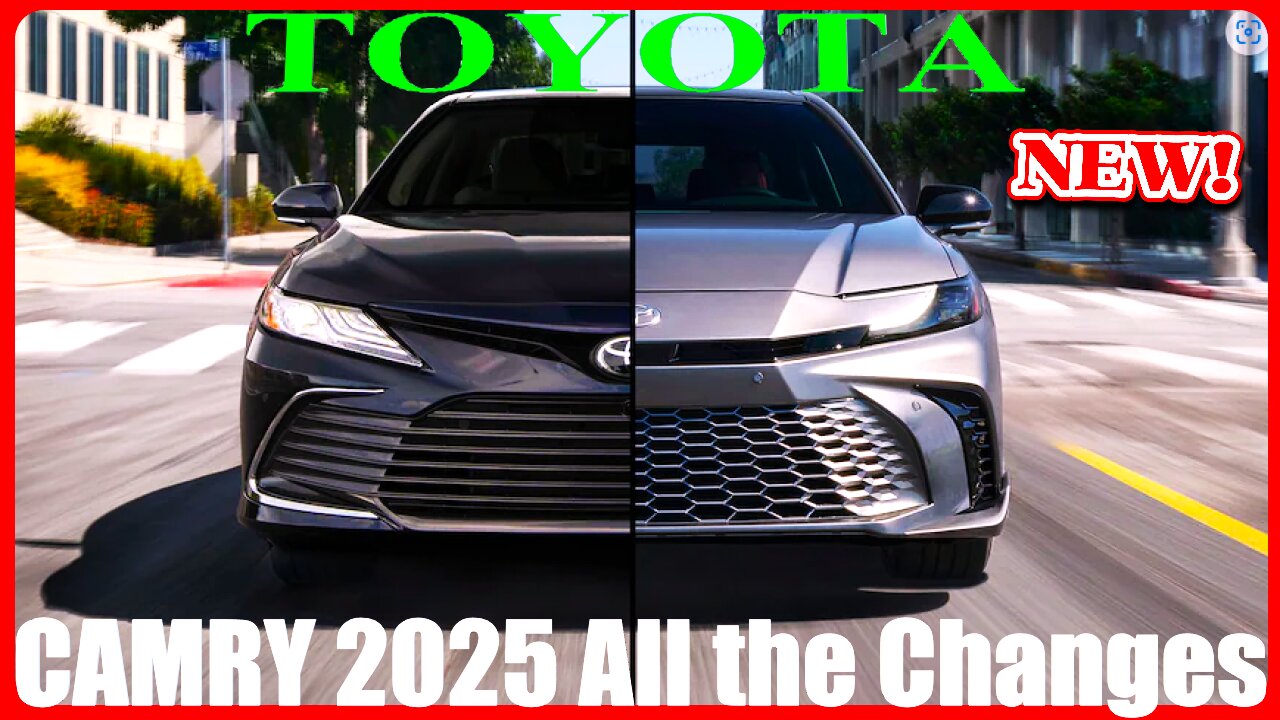Premium Only Content

TOYOTA CAMRY 2025 All the Changes #toyota #camry #2025 #all_changes
TOYOTA CAMRY 2025 All the Changes #toyota #camry #2025 #allChanges
Toyota just unveiled its newest Camry sedan, and the omnipresent four-door is entering its ninth generation since first going on sale for the 1983 model year over 40 years ago. The most recent Camry, introduced for 2018, was the most aggressively styled ever and infused with more sportiness than any Camry before it—so, which direction did Toyota take the new 2024 model? Though the latest midsize Toyota is by the automaker's own admission a heavily revised take on the current model, it makes a few big leaps forward, including adopting a hybrid-only powertrain lineup, new interior displays, and even sleeker styling. We lined up the new Camry alongside the outgoing version to highlight the biggest differences inside and out.
This view best highlights how similar the new Camry and the old one are underneath—just look at the side doors and roofline. They're essentially identical between the 2024 and 2025 Camrys, a typical sign that two cars share an underlying body structure.
If the old Camry looks somewhat ordinary in profile, its nose is anything but. Toyota offered two basic styling packages for the last-generation Camry, with the sportier SE and XSE model wearing the grille-tastic setup pictured here and more traditionally styled LE and XLE trims wearing toned-down bumpers and wider grilles without extra corner intakes.
Much like how the previous Camry's look was divided along trim level lines, so, too, were its badges separated by powertrain. Buy a gas-fed Camry—which came with either a 2.5-liter I-4 or a 3.5-liter V-6—and your sedan wore plain chrome Toyota badges front and rear. Opt for a hybrid, and those badges came with a blue accent. Hybrids also got "HYBRID" trunklid badges next to a little blue-and-chrome squiggle.
Where before only hybrid variants wore the blue-tinged Toyota badges front and rear (as have all hybrid Toyota products for years), the new Camrys do away with it altogether. Which is strange, of course, given that you can only buy a 2025 Camry with hybrid power.
There is a lot going on on the old Camry's tail—starting with that faux diffuser element jutting from the lower bumper. Again, this is the sportier SE trim, but every 2018-2024 Camry got this swoopy backlight and those teardrop-tattoo-like creases dripping from each taillight.
Toyota giveth ergonomics, and Toyota taketh them away. Entry level LE and SE Camrys get a smaller 7.0-inch digital gauge cluster and an 8.0-inch touchscreen, while XLE and XSE variants get the larger 12.3-inch.
Rear seat space in the old Camry is adequate, with decent (though not quite Accord-matching) legroom and a nice cushion height. Unlike the latest Accord, the Camry offered rear-seat air vents and USB ports; those niceties are limited to the range-topping Accord Touring—a veritable sin on such a large car.
Given how the 2025 Camry is, effectively, a 2024 Camry in fresher drag, we suspect cabin space to remain virtually the same. That said, equipment levels take a big leap forward, especially on the standard side of things. Even the base Camry LE an SE models get the aforementioned digital gauge cluster displays, plus dual-zone climate control, a Qi wireless phone charger, 16-inch aluminum wheels, LED headlights, and a smart key with pushbutton starting.
Toyota's Camry lineup was crowded with choices—there were effectively parallel product lines, one with gas power and the other with hybrid motivation. The entry-level gas version were powered by a 2.5-liter I-4 engine with an eight-speed automatic transmission and produced between 202 and 206 hp and 182 and 186 lb-ft of torque depending on trim; all-wheel drive was optional only with those four-cylinder engines. Toyota was an outlier in continuing to offer its midsize sedan with a naturally aspirated V-6 engine, in this case a 3.5-liter good for 301 hp and 267 lb-ft of torque; the V-6 came standard on the sportiest Camry TRD model.
The Camry hybrid delivered markedly better fuel economy than either gas-only option, combining a 2.5-liter I-4 with a pair of electric motors and a planetary-type continuously variable automatic transmission to spin the front tires. The gas engine contributed 176 hp and 163 lb-ft of torque, while the primary electric motor added in 118 hp and 149 lb-ft; stir in the third motor, a starter-generator, and total system output stood at a decent 208 hp.
-
 LIVE
LIVE
Steven Crowder
2 hours ago🔴 Live Reaction: RFK Faces Senate Grilling After Employees Demand His Resignation
56,763 watching -
 LIVE
LIVE
The Rubin Report
1 hour agoPress Stunned by Trump’s Brutally Honest Message for Elon Musk
1,721 watching -
 1:01:50
1:01:50
VINCE
3 hours agoEpstein Victims Have Come Forth, The Names Have Not | Episode 118 - 09/04/25
140K71 -
 LIVE
LIVE
LFA TV
4 hours agoLFA TV ALL DAY STREAM - THURSDAY 9/4/25
4,868 watching -
 LIVE
LIVE
Badlands Media
6 hours agoBadlands Daily: September 4, 2025
4,048 watching -
 1:40:33
1:40:33
Dear America
3 hours agoEpstein Victims Vow To EXPOSE Everyone! + Are China and Russia Planning Against Trump?!
106K50 -
 LIVE
LIVE
Law&Crime
3 hours ago $2.12 earnedLIVE: Adelson Matriarch Murder Trial — FL v. Donna Adelson — Day 9
303 watching -
 LIVE
LIVE
The Big Mig™
1 hour agoCartels Are On Borrowed Time, Here Comes The BOOM!
4,926 watching -
 LIVE
LIVE
Matt Kohrs
12 hours agoMASSIVE Market Swings Incoming! || Top Futures & Options Trading Show
491 watching -
 LIVE
LIVE
Wendy Bell Radio
6 hours agoIt's All About the Benjamins
6,603 watching